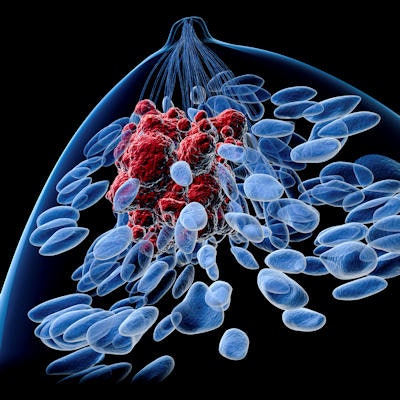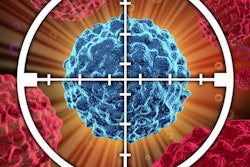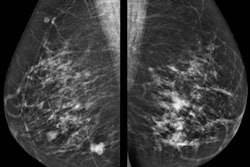
Contrast-enhanced mammography not only improves reader performance in interpreting mammograms in women with dense tissue but also boosts diagnostic confidence when compared with mammography alone, according to a study published online May 16 in the Journal of the American College of Radiology.
The results support the use of contrast-enhanced mammography as a low-cost, easily accessible alternative to MRI in this population, wrote a team led by Dr. Geunwon Kim, PhD, of Beth Israel Deaconess Medical Center in Boston.
"Unlike MRI, the cost of contrast-enhanced mammography is similar to conventional mammography, and the time to image ... is substantially less than that required for MRI," the group wrote. "Moreover, implementation of contrast-enhanced mammography is easier than MRI because it can be implemented with a software upgrade to some existing digital mammography equipment rather than requiring purchase of an entirely new machine."
Since contrast-enhanced mammography is currently only approved for diagnostic use, the authors sought to investigate its performance for breast cancer screening. They conducted a study that included 64 mammography exams acquired with and without contrast between December 2014 and June 2016. Of these exams, 64% were in dense breast tissue; 48 were found to be negative, five were biopsy-proven benign, and 11 were malignant (women with negative results were followed for two years with no evidence of cancer).
Ten breast imagers with a variety of experience rated the mammograms first and then the contrast-enhanced exams, using BI-RADS categories and a five-point scale for confidence in diagnosis. The analysis included 635 reader interpretations.
The researchers found that average sensitivity and specificity for cancer detection improved with contrast-enhanced mammography, although these improvements were not statistically significant. What did prove significant, however, was reader confidence in diagnosis, and the researchers noted a trend toward improved confidence as breast density increased.
| Contrast-enhanced mammography vs. mammography | |||
| Performance measure | Mammography alone | Contrast-enhanced mammography | p-value |
| Sensitivity | 0.86 | 1 | 0.08 |
| Specificity | 0.85 | 0.88 | 0.20 |
| Confidence level of readers (five-point scale) | 3.6 | 4 | < 0.001 |
| Confidence level of readers by breast tissue density (five-point scale) | |||
| Scattered fibroglandular | 3.7 | 4.1 | < 0.001 |
| Heterogeneous fibroglandular | 3.5 | 3.9 | < 0.001 |
| Extreme fibroglandular | 3.3 | 3.9 | < 0.001 |
The study suggests that contrast-enhanced mammography could improve cancer detection and reader confidence -- which could then reduce false positives, according to the group. But more research with a bigger patient cohort is needed.
"There is growing interest in offering contrast-enhanced mammography for breast cancer screening, particularly in women with dense breast tissue or those at high risk for breast cancer, as an alternative to breast MRI," the team wrote. "A retrospective reader study is a useful approach for studying screening contrast-enhanced mammography because a large number of cases with breast cancer can be compared across modalities."




















